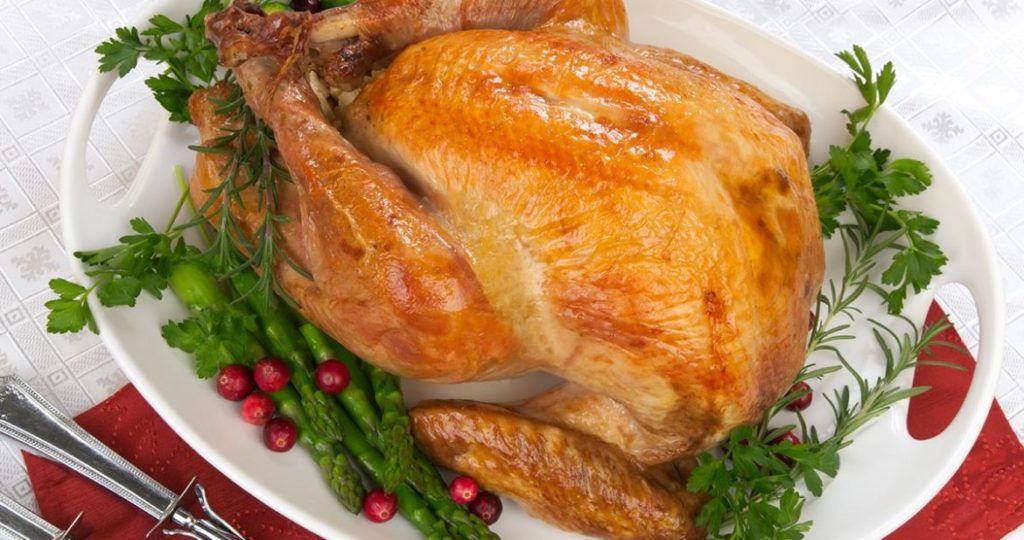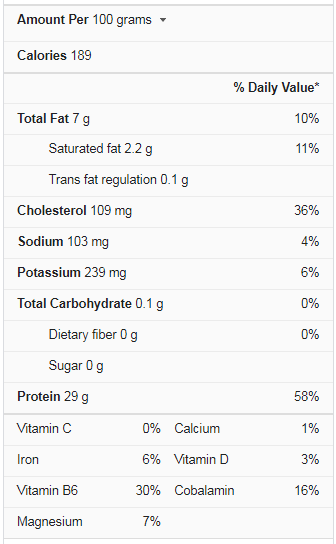While turkey is a classic Christmas bird, it’s also delicious any time of year, also most of the year. It’s only available in portions rather than full birds. Our tutorial teaches how to cook a turkey for a crowd, including bringing and carving. Turkey provides all of the nutritional benefits of chicken but with a reduced-fat level. This benefits one’s health, although it implies that the flesh may be a little dry.
Cooking a turkey, large or small, is much easier. The trick is to start with a well-prepared turkey and then take precautions to prevent it from drying out while cooking. After selecting a turkey that meets your needs, season it to taste, fill it (if desired), and roast it until soft and golden brown.
Turkey Nutrition Facts
What is Exactly Turkey?
Turkey meat, usually known as simply turkey, is the meat of turkeys, both domesticated and wild. It’s a popular fowl dish, particularly in North America, where it’s served during culturally significant events like Thanksgiving and Christmas and in everyday cooking. In the United States, turkey is a major meat source.
In 2019, Americans consumed 5.3 billion pounds of turkey, equating to approximately 16.1 pounds per person. It’s also more than double what Americans ate 50 years ago. Since then, scientists have learned a great deal about the many health benefits that turkey can provide. Turkey has a lot of nutrients and is generally healthier than red meat, and many people use it as a beef substitute in recipes.
How Many Types of Turkey?
Here are different types of turkey:
- Free-range: This bird is not raised in a cage and is free to graze on any grasses or grains it can find in its pen, which is generally considered a more humane and healthy poultry farming process.
- Organic: The U.S.D.A. reU.S.D.A.hat all turkeys sold as organic must be raised free-range, without antibiotics, and fed an organic and vegetarian diet that has not been treated with pesticides.
- Natural: Natural turkeys are generally less expensive than organic and are often of comparable quality. But there is no government guarantee to back up the word “natural” on a label. You must read on to determine if the bird is antibiotic-free, free-range, and raised on a vegetarian diet.
- Kosher: With rabbinical supervision, turkeys with the “kosher” label have been farmed and slaughtered according to Jewish dietary custom. After slaughter, they also undergo a salting process that gives the meat a juicy texture. (Don’t brine a kosher bird.)
- Conventional: This is the standard supermarket turkey. The variety is the Broad Breasted White, bred to have a plumper, broader breast. A conventional turkey should be brined; it will noticeably improve the texture. And use an open hand when it comes to seasonings since the turkey won’t offer many flavors of its own.
- Heritage: Heritage turkeys are old-fashioned varieties of birds that were common in America until the 1920s. They have a richer, more distinct flavor, are more like a game bird, and have a greater proportion of dark meat. Breeds include Narragansett, Jersey Buff, Standard Bronze, Bourbon Red, and White Holland.
- Wild Turkey: It is illegal in the United States to sell a wild turkey thot by a hunter; thus, most “wild” turkeys on the market are pasture-raised — often free-range heritage birds. To procure a truly wild turkey, you will need to either shoot one yourself or befriend a hunter.
- Self-basting: These turkeys have been injected with a solution generally consisting of butter or oil and salt, and sometimes herbs, spices, and preservatives. Self-basted turkeys are sometimes not labeled as such, so make sure to check the ingredients list. If you see anything other than “turkey,” chances are it is a self-basting bird, and please do not bring it.
Choose the Best Turkey
- Turkey should be purchased from a reputable source, such as a reputable supermarket, a local butcher, a farmers’ market or shop, or an internet mail-order company. The last four sources are probably the most likely to give you the most about the turkey, such as where it originated from and how it was raised, out of the five. Traceability like this ensures that the turkey was handled humanely while alive; the greater the degree of welfare with which a turkey was raised, the better the flesh quality.
- The most expensive turkey is organic because the most severe agricultural regulations were followed at all phases of the animal’s life, including allowing the animal to roam outside during the day and feeding it a mostly organic diet. Their flesh is solid and flavorful because they are allowed to mature slowly; yet, they may be less plump than indoor-reared birds because they have had a lot of exercise throughout their lives. If you want to buy organic, look for the Soil Association sticker.
- Free-range turkeys should have had some outdoor exposure and are typically less expensive than organic turkeys. Producers who meet the R.S.P.C.A.’s welR.S.P.C.A.’sidelines can also use the Freedom Food label.
- The most popular type of turkey is one that has been raised in a battery (or ‘factory’). Although they aren’t always labeled as such, the low price is a dead giveaway. Although such turkeys are less expensive, the conditions they are subjected to are appalling. They are packed in at high densities, with limited freedom to move and no access to sunlight – all of which results in visibly inferior flesh.
How to Cook Turkey?
This simple recipe will teach you how to prepare a turkey. The most common misconception in American cooking is that a juicy, perfectly cooked turkey is difficult to make for a rookie cook. Don’t be worried if this is your first time; it will work! There is nothing to be afraid of except the fear of being dry. Before Thanksgiving, ensure you get a meat thermometer; it will be the most important tool in the kitchen that day.
Ingredients
- One medium onion, coarsely chopped
- One stalk of celery, coarsely chopped
- 1 (12 pounds) whole turkey, neck, and giblets reserved
- Two tablespoons of kosher salt
- One tablespoon of ground black pepper
- One teaspoon of cayenne pepper
- Three tablespoons butter
- Four sprigs of fresh rosemary
- ½ bunch fresh sage, chopped
Directions
Here are the steps to follow:
- Preheat the oven to 325 degrees F (165 degrees C).
- Place onion, celery, and carrot in a large, shallow roasting pan.
- Place turkey, breast-side up, on top of vegetables in the roasting pan. Pat outside and inside of turkey dry with paper towels.
- Combine salt, black pepper, and cayenne pepper in a small bowl. Season inside of turkey with about 1/3 of the salt mixture. Fold wing tips under bird.
- Melt butter in a small saucepan over medium heat until edges turn golden, about 2 minutes. Add rosemary and sage; cook and stir until fragrant, about 1 minute.
- Place rosemary and sage inside the turkey’s cavity; reserve melted butter. Tie turkey legs together with twine.
- Brush melted butter over the turkey. Season with the remaining salt mixture.
- Bake turkey, uncovered, in the preheated oven until no longer pink at the bone and juices run clear, about 3 hours. An instant-read thermometer inserted into the thickest part of the thigh, near the bone, should read 180 degrees F (82 degrees C).
- Remove turkey from the oven and allow to rest in a warm area for 10 to 15 minutes before slicing.
What Seasoning Should you Put on a Turkey?
It’s preferable to season a turkey overnight, which you can accomplish by combining various herbs and spices in Seasoning and rubbing it into the meat. This gives the seasonings time to seep into the bird before cooking, resulting in better flavor penetration.
We’re guessing that you already have these turkey seasoning components in your spice cabinet and that this rub will be more flavorful than any store-bought turkey seasoning; plus, you’ll get all the benefits of being able to pronounce the ingredients:
- Dried thyme
- Dried rosemary
- Dried oregano
- Garlic powder
- Chili powder
- Smoked paprika
- Brown sugar
- Coarse salt
- Pepper
This wonderful turkey spice is tasty, somewhat sweet, and smoky. It combines some of the best common spices to make a fantastic turkey dry rub that will elevate any Thanksgiving or holiday meal!
Is Eating Turkey Healthy?
Turkey is high-protein, low-fat meat. Protein is required to form and repair the body’s bones, muscles, cartilage, skin, blood, and tissue. Protein is a macronutrient, which means it is required in large quantities by the body. Protein cannot be stored in the body, so it must be consumed daily. It’s a healthy method to obtain the protein you need as long as you don’t consume too much turkey. It’s also high in nutrients like magnesium, niacin, and other vitamins and minerals.
- Reduced Cancer Risk
- Diabetes Management
- Heart Health
Side Effects
Although eating turkey is very healthy, it has some side effects also:
- Clostridium perfringens, campylobacter, and salmonella are among turkey-associated pathogens. These can include diarrhea, fever, and stomach cramps, lasting anywhere from a few hours to many days. They have the potential to be fatal.
- While food poisoning is unpleasant at best, there is a much greater threat to our health that comes from farming these birds.
- The conditions that turkeys and chickens are kept in, and their immune systems are so weak, means that viruses can easily take hold, circulate and mutate.
- Experts have long suspected that the next worldwide pandemic will originate on a “poultry” farm. There are already avian diseases that have spread to humans via factory farms, with a 60 percent fatality rate.
- If these viruses continue to mutate – which they will – it will only be a matter of time before this virus works out how to transmit more easily from person to person.
How to Store Turkey?
When you arrive home, put the fresh turkey in the refrigerator. Please remove all the wrappings, then wipe them off with kitchen paper all over (even inside the cavities). If it came with giblets (neck, gizzard, heart, and liver), remove them and store them in a covered bowl in the refrigerator.
Place the turkey on a tray or platter that is broad and deep enough to catch any spilled blood or fluid. Cover with foil, but only loosely. Ensure the turkey does not come into contact with any other raw or cooked food in the refrigerator.
If you are not planning to cook the turkey right away after it has defrosted (see ‘prepare’ above), store it in the fridge immediately.
Whole turkeys and bits can be kept in the fridge for up to two days. Cook the turkey mince within 24 hours of purchase. Giblets should be boiled within two days of purchase for gravy and stock (but leave the liver out because it has a bitter flavor). They can also be used for stuffing.
Conclusion
Turkey will almost certainly be on the menu as you prepare your Thanksgiving feast with family and friends (and star in your delicious leftovers for days after that, too).
When it comes to turkey, fresh is better. Find turkey at your local grocery or, even better, get to know your local turkey farmers. Fresh turkey meat, rather than processed lunch meat or turkey bacon, is a certain way to boost your nutritional intake. Turkey is best served hot in a sandwich or salad or cold in a sandwich or salad.
Turkey is consumed all year, with turkey breast and sliced turkey being popular sandwiches and salad meats. On the other hand, most people only cook a whole turkey for special occasions like Christmas and Thanksgiving meals.


